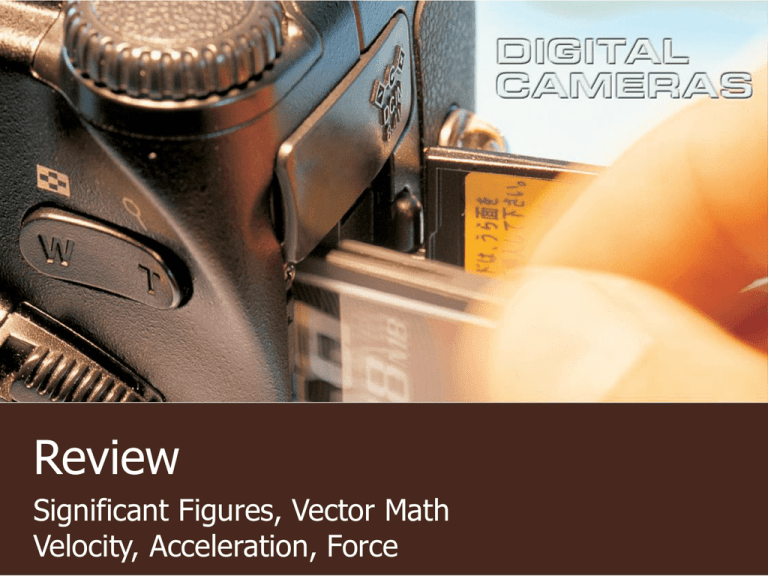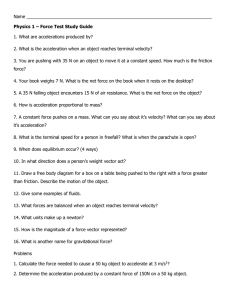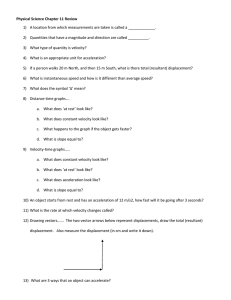Review
advertisement

Review Significant Figures, Vector Math Velocity, Acceleration, Force A Scientific Method Accuracy and Precision Accuracy – How close to the actual value Precision – How close to each other. A measurement of 4cm 1cm is the same as 3cm to 5cm Significant Figures Multiplication vs. Addition Each group take one of each measuring device (ruler, paper, and paper clip). Measure three objects and sum the results. Discuss the accuracy of your results. Explain how the measurement with the least significant figures affects your final result. Significant Figures Multiplication vs. Addition Addition 43.8 +5.67 49.4 Multiplication 43.8 x5.67 248. Variables Dependant – subject of the experiment Independent – The controlled variable E.G. How does speed of a sail boat change with wind? The speed of the sail boat is dependent on the wind. The wind is independent of the speed of the sail boat. Conversions 3Km 1000m 1hr 1 min ___m hr 1Km 60 min 60 sec ___s Conversions A mass of 300 grams is accelerated at a rate of 1km per minute. (F=ma) 300g g km Minute^2 1Kg 1000g (1 min)^2 (60 secs)^2 A Newton is a 1000 m 1 Km kg gm s2 ___kg g m ___s^2 Distance vs. Displacement Distance is the sum of the segments of the path, regardless of direction. Displacement is the straight-line distance from the point of origin to the ending point. Make a graph. Draw a line over to 3x and another line up to 4y. Determine the displacement and the distance. Vector vs. Scalar Scalar has magnitude 4 seconds Vector has magnitude and direction 5m/s East Relationships Directly Proportional x=2y Inversely Proportional x=1/2y Exponentially Proportional x=y^2 Graph Average Velocity The slope on a position-time graph is velocity (displacement divided by time). Position vs. Time Average Acceleration Average acceleration is the slope on a velocity-time graph. Velocity vs. Time slope v t a v t Position, Velocity, and Acceleration d slope t v slope t Horizontal and Vertical Components of Motion Equations with respect to the vertical component (y): v f vi at 1 2 y vi t at where y d f di or height 2 2 2 v f vi 2ay Solve for delta y in terms of the vertical components of vf and vi y Solve for t in terms of the vertical components of delta y, and v t Horizontal and Vertical Components of Motion Virtual Lab Cannon Exercise Juggling Exercise Horizontal and Vertical Projectiles Force www.HowStuffWorks.com “How Force, Power, Torque, and Energy Work” Forces on an Object Tension Friction Sled Feet Friction Newton’s First Law A body continues to maintain its state of rest or of uniform motion unless acted upon by an external unbalanced force. Motion and Newton’s Second Law Force equals mass times acceleration Net Force Net force is the force associated with acceleration (F=ma). Net force is the sum of all forces acting on a system. If the forces acting on a system do not cancel each other (add to a non-zero result, that is, are not in equilibrium), the system undergoes acceleration in the direction of said force. Note: Equilibrium means that there is a net force of zero (no acceleration). Weight and Normal Force Forces on an Inclined Plane Forces on an Inclined Plane Newton’s Third Law: Interaction Pairs To every action there is an equal and opposite reaction. Vector Components Vector Components Forces on an Inclined Plane Surface and Friction Static Friction Trajectory of a Projectile Horizontal and Vertical Components of Motion Which component directly determines time in the air? Which component directly determines distance traveled Relative Velocity Relative Velocity Angular Velocity How fast an angle is traversed. Circular Motion Angular Velocity Circumference Period Frequency Centripetal Acceleration Centripetal Force A centripetal force is not a new type of force; rather, it describes a role that is played by one or more forces in the situation, since there must be some force that is changing the velocity of the object. For example, the force of gravity keeps the Moon in a roughly circular orbit around the Earth, while the normal force of the road and the force of friction combine to keep a car in circular motion around a banked curve. Angular Acceleration Car Experiment – Virtual Lab Merry-go-round Experiment – Virtual Lab




